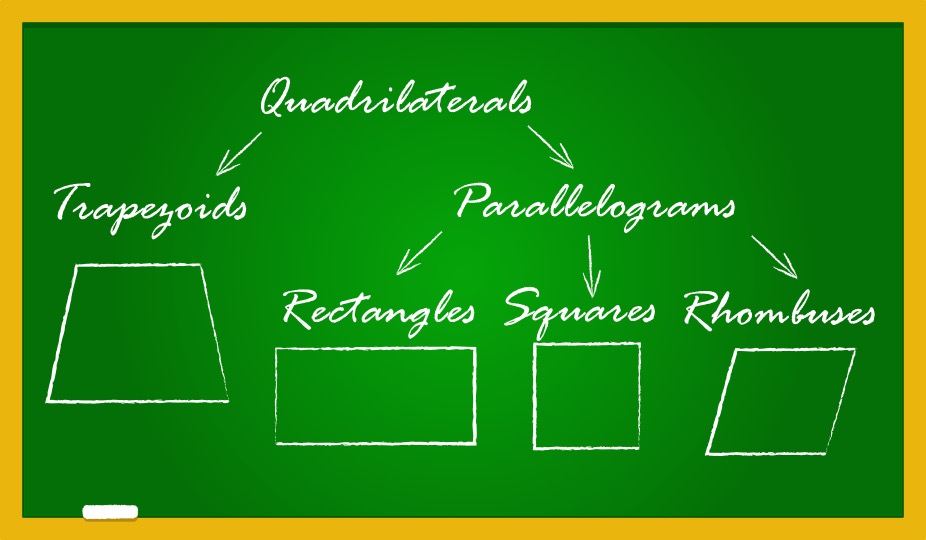

In Euclidean geometry, a quadrilateral is a four-sided 2D figure whose sum of internal angles is 360°. The word quadrilateral is derived from two Latin words ‘quadri’ and ‘latus’ meaning four and side respectively. Therefore, identifying the properties of quadrilaterals is important when trying to distinguish them from other polygons. So, what are the properties of quadrilaterals? There are two properties of quadrilaterals:
In this article, you will get an idea about the 5 types of quadrilaterals (Rectangle, Square, Parallelogram, Rhombus, and Trapezium) and get to know about the properties of quadrilaterals.
Here are the five types of quadrilaterals discussed in this article:
Hello and welcome! We’re thrilled to accompany you on your GMAT Quant preparation journey. By understanding your current standing and future goals, we’ll be able to provide tailored resources and strategies that will help you conquer the Quant section with confidence. Ready to take the first step? Let’s get started.
Get free Quant resources
Take a free mock
Here is a video explaining the properties of quadrilaterals:
This is what you’ll read in the article:Are you struggling with GMAT quant? e-GMAT provides structured learning from foundations to help you master the skills needed for a high score. Join the world’s most successful prep company for a free trial and see the difference it can make. We are the most reviewed online GMAT Prep company with 2600+ reviews on GMATClub, as of July 2023.
Get free GMAT Quant resources
Take a free mock
The diagram given below shows a quadrilateral ABCD and the sum of its internal angles. All the internal angles sum up to 360°. Thus, ∠A + ∠B + ∠C + ∠D = 360°
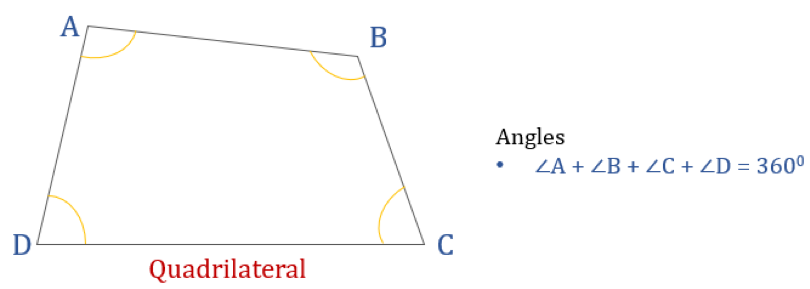
| Properties of quadrilaterals | Rectangle | Square | Parallelogram | Rhombus | Trapezium |
| All Sides are equal | No | Yes | No | Yes | No |
| Opposite Sides are equal | Yes | Yes | Yes | Yes | No |
| Opposite Sides are parallel | Yes | Yes | Yes | Yes | Yes |
| All angles are equal | Yes | Yes | No | No | No |
| Opposite angles are equal | Yes | Yes | Yes | Yes | No |
| Sum of two adjacent angles is 180 | Yes | Yes | Yes | Yes | No |
| Bisect each other | Yes | Yes | Yes | Yes | No |
| Bisect perpendicularly | No | Yes | No | Yes | No |
Let’s discuss each of these 5 quadrilaterals in detail:
We invite you to read our GMAT Focus Edition Series Articles, an invaluable resource to keep you at the forefront of your GMAT preparation journey.
A rectangle is a quadrilateral with four right angles. Thus, all the angles in a rectangle are equal (360°/4 = 90°). Moreover, the opposite sides of a rectangle are parallel and equal, and diagonals bisect each other.
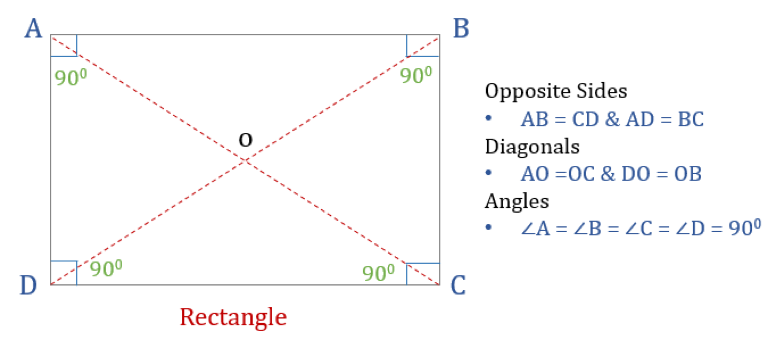
If the length of the rectangle is L and breadth is B then,
Begin your GMAT preparation with the only prep company that has delivered more than 700+ scores than any other GMAT club partner. Achieve GMAT 740+ with our AI-driven tools that you personalized feedback at every step of your GMAT journey. Take our free trial today!
Get free Quant prep resources
Take a free mock
Did you know e-GMATers have reported more 700+ scores than ever before in GMAT Club’s history? Watch this video to understand how e-GMAT has achieved this record-shattering result by investing and innovating with a single goal in mind – To create a platform that empowers students to achieve and deliver their very best.
Square is a quadrilateral with four equal sides and angles. It’s also a regular quadrilateral as both its sides and angles are equal. Just like a rectangle, a square has four angles of 90° each. It can also be seen as a rectangle whose two adjacent sides are equal.
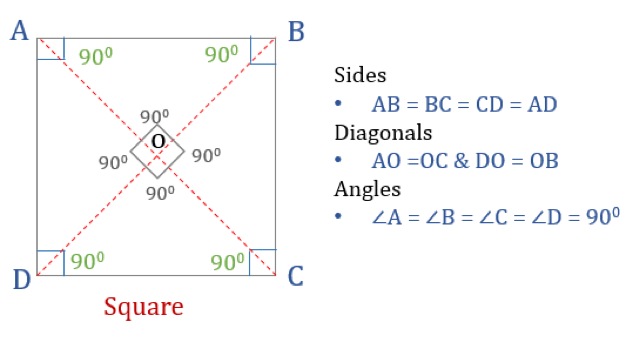
If the side of a square is ‘a’ then,
Scoring a Q50-51 on the GMAT helps you get a 700+ GMAT score. Start your journey of getting a Q50-51 on the GMAT with e-GMAT’s AI-driven online preparation course. Our xPERT not only curates the most optimized learning path but also tracks your improvement, ensuring that you get to your target Quant score quickly and reliably. Watch this video to know more:
A parallelogram, as the name suggests, is a simple quadrilateral whose opposite sides are parallel. Thus, it has two pairs of parallel sides. Moreover, the opposite angles in a parallelogram are equal and their diagonals bisect each other.

Take a free GMAT mock to understand your baseline score and start your GMAT prep with our free trial. We are the most reviewed online GMAT Prep company with 2600+ reviews on GMATClub.
Take a free mock
If the length of a parallelogram is ‘l’, breadth is ‘b’ and height is ‘h’ then:
A rhombus is a quadrilateral whose all four sides are equal in length and opposite sides are parallel to each other. However, the angles are not equal to 90°. A rhombus with right angles would become a square. Another name for rhombus is ‘diamond’ as it looks similar to the diamond suit in playing cards.
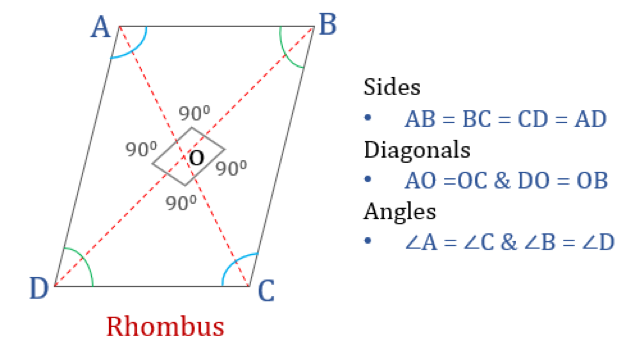
If the side of a rhombus is a then, perimeter of a rhombus = 4a
If the length of two diagonals of the rhombus is d1 and d2 then the area of a rhombus = ½ × d1 × d2
At e-GMAT, we strive to make the students’ life easier at every level and therefore, we have built this fantastic tool called the GMAT Personalized Study Planner. With this tool, you can not only find out the Quant and Verbal Sectional scores but also Sub-sectional scores in Quant (Algebra, Arithmetic, etc.) and Verbal (CR, RC, and SC) to achieve your target GMAT Score! Moreover, this tool will craft your very own study plan in 5 minutes. Register for our FREE Trial and create your personalized study plan in 5 mins!
Create your own Study Plan
A trapezium (called Trapezoid in the US) is a quadrilateral that has only one pair of parallel sides. The parallel sides are referred to as ‘bases’ and the other two sides are called ‘legs’ or lateral sides.
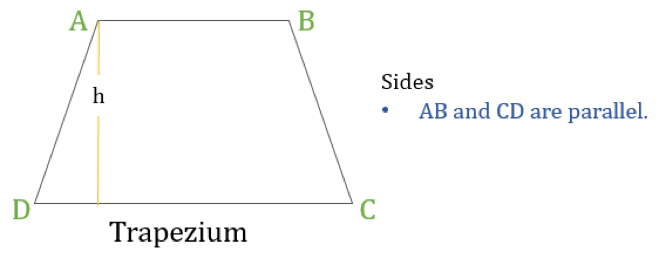
A trapezium is a quadrilateral in which the following one property:
If the height of a trapezium is ‘h’ (as shown in the above diagram) then:
The below image also summarizes the properties of quadrilaterals
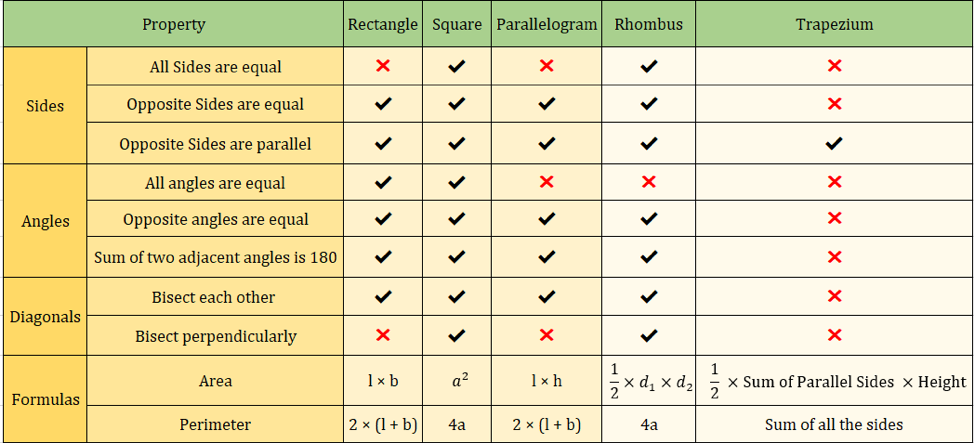
Are you struggling with GMAT quant? e-GMAT provides structured learning from foundations to help you master the skills needed for a high score. Join the world’s most successful prep company for a free trial and see the difference it can make. We are the most reviewed online GMAT Prep company with 2500+ reviews on GMATClub, as of April 2023.
Get free GMAT resources
Take a free mock
The below table summarizes the formulas on the area and perimeter of different types of quadrilaterals:
| Quadrilateral formulas | Rectangle | Square | Parallelogram | Rhombus | Trapezium |
| Area | l × b | a² | l × h | ½ × d1 × d2 | ½ × (Sum of parallel sides) × height |
| Perimeter | 2 × (l + b) | 4a | 2 × (l + b) | 4a | Sum of all the sides |
Further reading:
To ace the GMAT a well-defined study plan is required. Save 60+ hours on GMAT preparation by following these three steps:
Let’s practice the application of properties of quadrilaterals on the following sample questions:
Adam wants to build a fence around his rectangular garden of length 10 meters and width 15 meters. How many meters of fence he should buy to fence the entire garden?
Step 1: Given
Step 2: To find
Step 3: Approach and Working out
The fence can only be built around the outside sides of the garden.
Hence, the required length of the fence is 50 meters.
Therefore, option E is the correct answer.
Steve wants to paint one rectangular-shaped wall of his room. The cost to paint the wall is $1.5 per square meter. If the wall is 25 meters long and 18 meters wide, then what is the total cost to paint the wall?
Step 1: Given
Step 2: To find
Step 3: Approach and Working out
Hence, the correct answer is option E.
We hope by now you would have learned the different types of quadrilaterals, their properties, and formulas and how to apply these concepts to solve questions on quadrilaterals. The application of quadrilaterals is important to solve geometry questions on the GMAT. If you are planning to take the GMAT, we can help you with high-quality study material which you can access for free by registering here.
Here are a few more articles on Math:
Watch this GMAT geometry-free webinar where we discuss how to solve 700-level Data sufficiency and Problem questions in GMAT Quadrilaterals:
Are you planning to enroll at top business schools? Let us help you conquer the first step of the process i.e., taking the GMAT. Take a free GMAT mock to understand your baseline score and start your GMAT prep with our free trial. We are the most reviewed online GMAT Prep company with 2500+ reviews on GMATClub, as of January 2023.
Get free prep resources